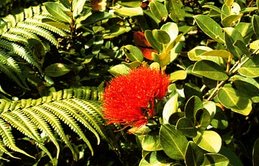
I spend quite a bit of time combatting mold and mildew in my house, especially around the fridge. I know bleach kills mildew and whitens any discoloration, but we have a cess pool and my husband says, "Don't use bleach!" Just what are mold and mildew, and why are they so happy at my house? How can I make them feel less welcome?
Mold and mildew are classified as fungi (fungus is the singular and fungi is the plural). Fungi do not make food of their own, but absorb the nutrients they need from plants, food, and dry leaves. They are are among the world's decomposers, which help break down dead materials inorder to be used again as soil. Mold organisms can be white, orange, green, or black, and mildew is white and powdery. Both reproduce by spores and can be a health hazard if left unchecked. These fungi need moisture, a food source, a place to grow, so the first step in controling them is to eliminate the source of moisture, then clean the area with detergent and water, followed by a cleaning solution of bleach and water. For those who cannot use bleach, there are bleach alternatives. So, like centipedes, mold and mildew have their job to do in our world. There is the classic mold experiment that young children can do: You will need a sandwich size ziplock bag, a half a piece of bread, and a small amount of water. Place the bread and water in the bag, seal it, and let the children observe the bread as the mold grows over the next few days. Even before the experiment, let the children draw or write their predictions on what will happen. By the way, that is not a picture of my house; I got the picture off the web.
Mold and mildew are classified as fungi (fungus is the singular and fungi is the plural). Fungi do not make food of their own, but absorb the nutrients they need from plants, food, and dry leaves. They are are among the world's decomposers, which help break down dead materials inorder to be used again as soil. Mold organisms can be white, orange, green, or black, and mildew is white and powdery. Both reproduce by spores and can be a health hazard if left unchecked. These fungi need moisture, a food source, a place to grow, so the first step in controling them is to eliminate the source of moisture, then clean the area with detergent and water, followed by a cleaning solution of bleach and water. For those who cannot use bleach, there are bleach alternatives. So, like centipedes, mold and mildew have their job to do in our world. There is the classic mold experiment that young children can do: You will need a sandwich size ziplock bag, a half a piece of bread, and a small amount of water. Place the bread and water in the bag, seal it, and let the children observe the bread as the mold grows over the next few days. Even before the experiment, let the children draw or write their predictions on what will happen. By the way, that is not a picture of my house; I got the picture off the web.

No comments:
Post a Comment